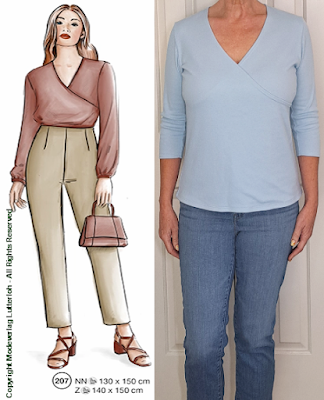Supplement 326 Model #209 - 2022
Knit top altered for maternity
Hello again folks. I recently found out that there will be a new baby in our family so I wanted to help out the mother-to-be since maternity clothes can be very expensive these days. Unfortunately all I had to model this shirt was my paper dress form with a pillow stuffed under the waist. You'll have to use your imagination for this one. 😏
Pattern Hints:
For this pattern hack I looked for a fairly close fitting knit dress with just a few pattern pieces. Just like all Lutterloh patterns this one was easy enough to enlarge. I did draw out the entire dress pattern and shortened it below the shirt length but not as long as the dress.
Design Changes:
I looked around the internet and found lots of pages to describe the necessary changes to make this shirt suitable for maternity. Besides shortening this pattern to a tunic length, the maternity modifications are fairly straightforward. Below is a picture of how I changed the pattern. You can see the cutting line for the top version #210. I cut my pattern at the next dot for enlarging the pattern, straight across to the center front. The real change, as you might imagine, is around the waist area. I split the pattern just above the waist mark and added four inches of paper to lengthen the pattern in this area. I also straightened out the pattern in this area to make room for growth. Next, I marked a gathering line from four inches below the armhole to about three inches shy of the bottom hem. I made no changes to the back pattern piece or the sleeve. When I sewed the side seams I gathered only the front to match the length of the back side seams.
Fabric Used/Suggested:
The fabric for this particular top is a very stretchy cotton/rayon with spandex knit. This shirt has enough stretch to take the mother-to-be all the way to the finish line! For a top for a smaller baby bump I would recommend a knit with either less stretch or at least with excellent recovery properties.
Closing Hints:
I'll save this pattern for future iterations, just in case. As long as you can find a close fitting T-shirt or dress pattern for knits this alteration was a breeze to accomplish. I've seen this type of maternity top all over the internet but it's usually only available in basic solid colors. I'm glad I worked out the pattern to give this mother-to-be a little more variety in her wardrobe for this short stage in her life.
Working on maternity patterns is a nice change of pace for a little while. I may attempt more in the near future since the Lutterloh company has been including a few in their supplements lately. Until next time then........
Happy sewing everyone, from,
Ann in Calif.




















